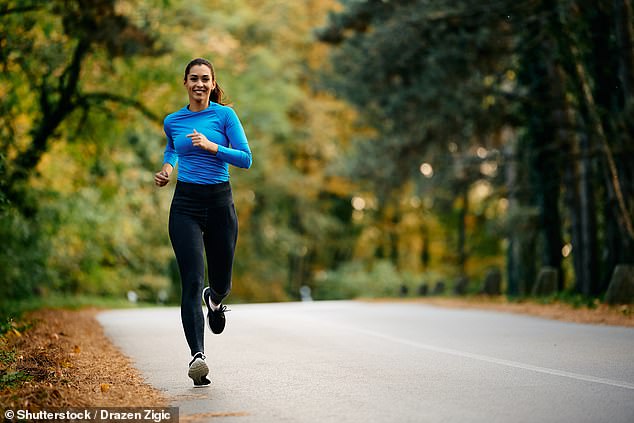Slow and steady wins the race, the old saying goes, and now it seems to apply to the health benefits of exercise as well.
In fact, there is growing evidence to suggest that slow, regular running may strengthen your heart, reduce your risk of type 2 diabetes, and boost your immune system and overall fitness far better than sprinting.
The same goes for other cardiovascular exercises that are performed at a slower pace, such as swimming, rowing and cycling. In fact, running clubs are now being created just for runners and joggers.
“Slow running is becoming increasingly popular among recreational exercisers,” says Dan Gordon, associate professor of cardiorespiratory exercise physiology at Anglia Ruskin University.
‘We’ve been through a high-intensity interval training (HIIT) craze over the last decade or so, and while I’m not arguing against the potential benefits of HIIT, one downside is that it’s challenging and therefore difficult to get started with if you’re not particularly fit.’
There is growing evidence to suggest that running at a slow, steady pace may strengthen the heart. (File photo)

Professor Gordon says: “If we are sedentary, we are very susceptible to disease.” (File photo)
This results in a high dropout rate, he says, whereas with slower, less strenuous exercise people are less likely to give up.
“There are also proven physiological benefits to running at this effort level,” he says.
This was demonstrated by a Danish study published in 2015, which followed 5,000 people for 12 years.
four groups: non-runners (sedentary) and light, moderate or strenuous runners.
Slow- and moderate-pace runners had the lowest rate of death from any cause, while strenuous runners had a death rate similar to that of the sedentary group.
One theory is that this could be due to the way slow running lowers resting blood pressure and strengthens the heart.
Professor Gordon explains: “Basically, it improves efficiency by making the heart muscle bigger. If the heart muscle is bigger, it can contract more forcefully. It also increases the size of the inner chambers of the heart so it can hold more blood per pump.”
Slow running also improves endurance as you can run at a slower pace for longer; this increases red blood cell production, which in turn means your blood can carry more oxygen.
These heart muscle adaptations don’t increase with training at a higher intensity. Another benefit of slow cardio — also known as “zone 2” cardio, when you work at 60 to 70 percent of your maximum heart rate — is that it causes your body to use stored fat for fuel, says Dr. Lindsy Kass, an exercise physiologist at the University of Hertfordshire, instead of carbs, as happens with higher-intensity exercise.
Metabolising fat is more efficient and better for overall health, Professor Gordon adds: “It is associated with better blood glucose levels and reduces the risk of type 2 diabetes.
‘Studies have shown that gains in VO2max (oxygen capacity) and speed on race day are about 1 percent better for athletes who include more slow runs in their training programs.’

Experts say it’s not the speed that matters, but the intensity of the effort. (Archive image)

Some studies show that the eccentric phase of a lift takes twice as long to complete. (File photo)
This is a major competitive advantage, and once you know it, it’s not surprising to discover that most elite athletes spend up to 80 percent of their training in Zone 2.
“I used to work with the British rowing team and although their races are about six minutes long, they spend an hour and a half rowing slowly three times a week,” says Dr Kass. “The first year they trained like this was the year they started winning all the medals.”
Another reason elite athletes spend time training at lower intensities is to reduce stress on their bodies, helping them avoid infection or injury.
Professor Gordon said: “If we are sedentary, we are quite susceptible to getting sick. But if we do moderate intensity exercise we develop a better immune response and reduce our susceptibility to getting sick.”
“But when we start doing high-intensity exercise, we need a lot more time to recover (up to 48 to 72 hours afterward), and during that recovery period you are immunosuppressed. So the more high-intensity exercise you do, especially if you don’t take adequate recovery time between sessions, the more likely you are to get sick and infected, and to get injured.”
So what do we mean by slow running? Experts say it’s not about speed, but intensity of effort. “Try singing to yourself as you run, and if you can do it without panting, you’ve done it right,” advises Professor Gordon.
The same philosophy applies to weight resistance work.
Slowing down takes the momentum out of a movement, which encourages good form and reduces the risk of injury.
Some studies show that taking twice as long in the “eccentric” lengthening phase of a lift (e.g., lowering from a pull-up) as in the “concentric” shortening phase (the pull-up portion) can improve muscle growth.
But don’t go too slow – you’ll tire faster and won’t be able to lift as heavy weights as you should to get the full muscle-strengthening benefit, says Dr Richard Blagrove, a senior lecturer in physiology at Loughborough University.
He adds: “Most people would be better off doing a ‘controlled’ (not super slow) eccentric phase and an explosive (as fast as possible) concentric phase with moderate to heavy loads for the majority of their resistance training, with some exercises geared toward developing power.”

